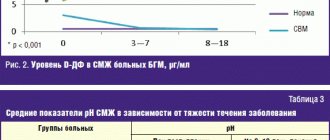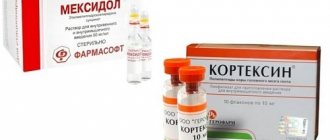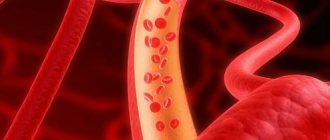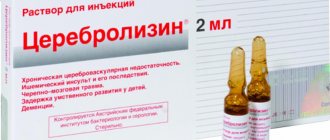ANTIMICROBIAL DRUGS FOR THE TREATMENT OF PURULENT BACTERIAL MENINGITIS
This paper presents antimicrobial drugs that can be used for etiotropic therapy of bacterial meningitis and CNS infections. This paper outlines antimicrobial agents which can be used for the etiotropic therapy of bacterial meningitis and CNS infections.
E.N. Padeiskaya - Doctor of Medical Sciences, Professor, Moscow Ye.N. Padeiskaya - prof., MD, Moscow
Introduction
Purulent-inflammatory processes in the membranes and brain tissue are among the most severe forms of infectious pathology. In treatment regimens for bacterial infections of the central nervous system (CNS), the main place is occupied by drugs that are highly active against pathogens. Means of pathogenetic and symptomatic therapy are also important for this pathology, without the use of which it is practically impossible to ensure complete success of treatment. The scope of the publication, unfortunately, does not allow us to consider the schemes and features of therapy (including combination therapy) for meningitis depending on the causative agent of the infection (including issues of drug resistance), the age of the patient, the characteristics of the course of the disease and a number of other factors. By the end of the twentieth century, a large number of highly effective antibacterial agents had been developed, but not all of them can be used to treat CNS infections. The main obstacle is the poor penetration of the drug through the blood-brain barrier (BBB) during inflammatory processes in the meninges, as well as adverse reactions and a narrow therapeutic range, which precludes increasing the dosage. Table 1. Causative agents of purulent meningitis and purulent-inflammatory processes of the central nervous system of bacterial etiology
| Aerobic bacteria | Anaerobic bacteria |
| Neisseria meningitidis* Haemophilus influenzae* Streptococcus pneumoniae* Streptococcus gr. “B” Streptococcus viridans Staphylococcus aureus Enterococcus Escherichia coli Salmonella spp., including S.typhi, S.enteritidis Klebsiella pneumoniae Serratia marcescens Proteus spp. Pseudomonas aeruginosa Citrobacter diversus Listeria monocytogenes | Bacteroides fragilis Bacteroides spp. Peptostreptococcus Fusobacterium meningosepticum (other representatives of anaerobic bacteria are also possible) |
| *Have a major role in the etiology of meningitis (up to 80% or more) | |
For CNS infections, treatment should begin as early as possible, and in the first stages, before identifying the pathogen, we are always talking about empirical therapy. Once a microbiological diagnosis has been established (which is not always easy in the case of successful early empirical therapy), etiotropic treatment should be carried out in accordance with data on the sensitivity of the pathogen. It is necessary to take into account the possibility of mixed infection, including aerobic-anaerobic, in particular during purulent processes in brain tissue. Table 2. Chemotherapy drugs that can be used to treat bacterial meningitis and bacterial infections of the central nervous system
| Drug groups | Medications |
| Penicillins | Benzylpenicillin, ampicillin, oxacillin, methicillin, mezlocillin, piperacillin, ticarcillin |
| Cephalosporins | Cefuroxime, ceftriaxone, cefotaxime, ceftazidime, cefpirome |
| Carbapenems | Meropenem |
| Aminoglycosides | Gentamicin, amikacin, tobramycin, netilmicin |
| Glycopeptides | Vancomycin, teicoplanin |
| Para-nitrophenyls (phenicols) | Chloramphenicol |
| Nitroimidazoles | Metronidazole, tinidazole, ornidazole |
| Fluoroquinolones | Pefloxacin, ciprofloxacin, ofloxacin, trovafloxacin being studied |
| Sulfonamides + diaminopyrimidines | Co-trimoxazole, sulfatone and analogues |
| Sulfonamides | Sulfazine, sulfalene, sulfamonomethoxine and some others |
| Quinoxaline di-N-oxide | Dioxidine |
The optimal drug for the treatment of CNS infections must meet the following requirements:
1. It must be a highly active in vitro compound with activity against most pathogens of bacterial meningitis.
2. Preferred are drugs with low molecular weight, lipophilic properties and a low degree of binding to plasma proteins. 3. The drug should penetrate well through the BBB during inflammatory processes in the meninges, providing a bactericidal effect at the site of infection. The latter should be specially emphasized, since even a drug with a bactericidal type of action cannot always provide this effect due to insufficient concentration in the cerebrospinal fluid and brain tissue. Bactericidal concentrations are especially important, since the central nervous system is an organ that is practically not provided with immune protection, including cellular immunity factors. The degree of penetration through the BBB depends on the characteristics of the pathogenesis of the disease (associated with the infectious agent), the stage of the disease, and the dose of the drug. Concentration indicators are determined by the timing of the study in relation to the administration of the drug, the start of a course of treatment and the onset of the disease. 4. Long-acting drugs have an advantage, especially those that are slowly (slower than from the blood) cleared from the cerebrospinal fluid (CSF). 5. The drug should be characterized by low toxicity, good tolerability when used systemically, a large therapeutic range and not cause adverse reactions from the central nervous system. It is equally important that the drug is well tolerated when administered into the spinal canal, intrathecally, or when irrigating a wound in cases of brain injury or surgery. Dosage forms for parenteral administration are required. On the other hand, drugs with a high degree of bioavailability when administered orally (more than 80%) and at the same time with a high degree of penetration into the cerebrospinal fluid during meningitis are of undoubted value. Such drugs can be used orally to treat meningitis, usually after initial parenteral therapy (and sometimes only orally) in patients with moderate disease, preserved consciousness, and unimpaired swallowing. Purulent meningitis is a severe pathology that requires early, urgent treatment.
Antimicrobial drugs should be prescribed in maximum doses that provide bactericidal concentrations in the cerebrospinal fluid. Doses cannot be reduced as clinical improvement and cerebrospinal fluid normalization occur, since the recovery process simultaneously leads to a decrease in the permeability of the BBB to the drug. Table 3. Cephalosporin drugs used to treat bacterial meningitis
| Generation of cephalosporins | A drug | Doses* single, adults intravenously or intramuscularly, g | Number of injections per day | Penetration into CSF: % CSF/serum |
| II | Cefuroxime | 1,5 | 3 — 4 | 16 — 58 |
| III | Ceftriaxone | 2 | 1 | 4 — 17 |
| Cefotaxime | 2 | 2 — 3 | 6 — 27 | |
| Ceftazidime | 2 | 3 | 28 — 40 | |
| IV | Cefpir | 2 | 2 | 4 — 87 |
| * At the indicated doses, therapeutic concentrations in the cerebrospinal fluid are achieved in relation to pathogens sensitive to the drug | ||||
Table 4. Main characteristics of the drug ceftriaxone
| Index | Ceftriaxone (main characteristics) |
| Antimicrobial spectrum | Most aerobic gram-positive and gram-negative bacteria, some anaerobes are highly sensitive; P. aeruginosa strains are moderately susceptible or resistant; enterococci, listeria resistant |
| T1/2, h | Adults - 8 hours; children in the first days of life and people over 75 years old - up to 16 hours |
| Cmax mg/l in blood | After administration: 2 g intravenously - up to 270 mg/l 1 g intravenously - up to 150 mg/l |
| Concentration in CSF | After intravenous administration 50 - 100 mg/kg - more than 1.4 mg/l; average during course treatment - 3.5 mg/l (MIC* for sensitive strains: 0.003 - 0.025 mg/l; for staphylococcal strains - possibly 2 - 4 mg/l) |
| Doses and frequency of administration per day for meningitis | Adults and children over 12 years of age: 2 - 4 g 1 time / day. Infants and young children - 100 mg / kg (no more than 4 g) 1 time / day; in some observations - a daily dose of 2 injections, an interval of 12 hours |
| * MIC—minimum inhibitory concentration. | |
Special part
In table 1 and presents microorganisms that cause bacterial meningitis and the main groups of chemotherapeutic drugs that can be used to treat bacterial infections of the central nervous system. Drugs of the group of macrolides, lincosamines, nitrofuran and quinoline derivatives, non-fluorinated quinolones, tetracyclines are not used for the treatment of bacterial meningitis and infections of the central nervous system, since they poorly penetrate the BBB during inflammation of the meninges and do not provide the necessary therapeutic concentrations in the cerebrospinal fluid and brain tissue. Table 5. Efficacy of fluoroquinolones for bacterial meningitis in the absence of a therapeutic effect from previous therapy*
| Drugs, doses, intravenous | Number of patients | The causative agent of infection | Efficiency (recovery, improvement) |
| Ciprofloxacin 200 mg 2 times a day, 10 days | 20 | E. coli, E. cloacae, P. mirabilis, P. aeruginosa, K. pneumoniae, A. calcoaceticus | 18 |
| Pefloxacin 400 - 800 mg 2 times a day, 8 - 45 days | 37 | S. aureus, E. coli, S. epidermidis, P. aeruginosa, A. calcoaceticus, E. cloacae C. diversus, Salmonella spp. | 29 |
| * According to reviews [17, 18, 20] modified | |||
Among the etiotropic drugs that are used to treat bacterial infections of the central nervous system, there is not yet a drug that satisfies all the previously listed requirements. Nevertheless, high bactericidal activity, a wide antibacterial spectrum, concentrations in the cerebrospinal fluid that provide a bactericidal effect against the vast majority of pathogens of bacterial meningitis, combined with low toxicity and good tolerability, make it possible to consider cephalosporins of the third and fourth generations
(Table 3 and) as the most important drugs for the treatment of bacterial meningitis, including for empirical therapy, although they do not solve all the issues of etiotropic treatment [1 - 7].
These drugs differ in pharmacokinetic characteristics (determining the frequency of administration per day) and features of the antimicrobial spectrum. Accordingly, the choice of drug for empirical therapy and with an established microbiological diagnosis is also different. Of particular interest is ceftriaxone. Its high activity and fairly wide spectrum are combined with prolonged action; the drug is recommended for use once a day (see Table 4). Ceftriaxone has been shown to be highly effective in meningitis caused by N.meningitidis, H.influenzae, S.pneumoniae, Streptococcus gr.B, S.viridans, S.aureus and S.epidermidis (with the exception of strains resistant to methicillin), K.pneumoniae, E. coli [3, 6, 8]. Ceftriaxone is resistant to the action of Haemophilus influenzae b-lactamases and is effective when strains resistant to penicillins by this mechanism are isolated [1]. Table 6. Penetration of ofloxacin (OPL) into the CSF in purulent meningitis*
| Time of sampling after the third injection in the blood | Duration of treatment (OPL 200 mg intravenously every 12 hours) | |||
| 2 – 4 days | 10 – 14 days | |||
| µg/ml | % of blood | µg/ml | % of blood concentration | |
| 30 min | 1,14 | 30 | 1 | 24 |
| 3 hours | 1,8 | 64 | 1,1 | 65 |
| 6 hours | 1,19 | 98 | 0,95 | 165 |
| 12 h | 0,96 | 134 | 1,2 | 169 |
| * Data from I. Pioget et al., 1989 [17, 18]; CSF samples were taken after the next three injections on days 2–4 and 10–14 of treatment; T1/2 OFL: blood - 7.8 hours, cerebrospinal fluid - 10.2 hours. | ||||
Cefotaxime, which is similar in spectrum of action to ceftriaxone, is highly effective in treating meningitis; Based on pharmacokinetic parameters, it should be used 2–3 times a day [5]. For infection caused by P. aeruginosa, the use of ceftazidime from the group of cephalosporins is indicated [4]. The fourth generation cephalosporin cefpirome, apparently, can take an important place in the treatment of bacterial meningitis (caused by gram-negative flora and streptococci), as it provides a high concentration in the cerebrospinal fluid. After intravenous administration of 2 g of cefpirome, the concentration in the CSF after 8 and 12 hours was 3.63 and 2.26 mg/l, which significantly exceeds the MIC90 for most drug-sensitive gram-negative bacteria, streptococci, pneumococci and 2-3 times for staphylococci (according to review [9]). The second generation cephalosporin, cefuroxime, can be used to treat bacterial meningitis, but is inferior in effectiveness to drugs of the third and fourth generations and requires administration 3-4 times a day. Penicillin group drugs have played an important role in the treatment of meningitis for decades.
, first of all benzylpenicillin, then ampicillin.
Therapeutic concentration in the cerebrospinal fluid is achieved only with the use of high daily doses of drugs. Ampicillin, due to its wider spectrum and activity against Listeria, is considered by most clinicians as one of the main drugs for initial empirical treatment of meningitis (especially in newborns), usually in combination with cephalosporins. Listeria can cause meningitis in newborns as a result of intrauterine infection, and decreased immunity is a predisposing factor for the occurrence of listeria meningitis in adults. The disadvantage of penicillins used for meningitis is the need to administer them parenterally 4-6 times a day. Recently, the drug meropenem, a broad-spectrum b-lactam antibiotic from the group of carbapenems
[10].
Meropenem is highly active against enterobacteria, streptococci, listeria, much more active than cephalosporins of the III and IV generations and aminoglycosides against staphylococci and enterococci, highly active against anaerobes, including bacteroides (in relation to a number of strains it is more active than nitroimidazoles). Meropenem penetrates well into the CSF during inflammation of the meninges and is considered as an important reserve drug when standard starting or etiotropic therapy is ineffective. Meropenem is effective for bacterial meningitis in monotherapy, including in children, and is equal or superior in effectiveness to third-generation cephalosporins or appropriate combination therapy of cephalosporins in combination with aminoglycosides. Meropenem for meningitis is used intravenously: adults 2 g every 8 hours, children 20 - 40 mg/kg also every 8 hours; It is not recommended to prescribe the drug to children under 3 months of age [10, 11 – 13]. Meropenem showed significantly higher activity in the treatment of meningitis caused by penicillin-resistant pneumococci in comparison with cephalosporins, including IV generation drugs [3]. Unlike another carbapenem, imipenem, meropenem is much more resistant to inactivation by the renal enzyme dihydropeptidase-I, and therefore there is no need to use it in combination with cilastatin. In patients with meningitis, meropenem does not induce convulsive reactions, which is a disadvantage of imipenem. Aminoglycosides
- gentamicin, amikacin, tobramycin, netilmicin (highly effective against gram-negative aerobic bacteria and staphylococci) are used to treat meningitis, although these drugs penetrate poorly through the BBB, are characterized by a number of toxic properties (nephro-, oto- and neurotoxicity) and a narrow therapeutic breadth.
Their use in bacterial meningitis, usually in combination therapy, is indicated for infections caused by gram-negative flora sensitive to aminoglycosides [14]. In recent years, the number of strains of gram-negative bacteria resistant to gentamicin has increased significantly, and determining the sensitivity of the pathogen when using aminoglycosides is especially important, including for choosing a drug in this group. The development of highly effective cephalosporins, meropenem, and fluoroquinolones (including ciprofloxacin, which is active against P.aeruginosa) makes it possible in a number of cases to avoid the use of aminoglycosides, including empirical starting therapy. The development of a regimen for the use of aminoglycosides, subject to the administration of a daily dose in one dose, and the use of less toxic drugs (in particular, netymicin in pediatric practice) can significantly reduce the risk of side effects [15]. of using endolumal administration of drugs
in the treatment of meningitis is controversial .
Currently, they try to resort to this method as rarely as possible, given the high effectiveness of parenteral therapy. Endolumbar administration is usually considered in relation to aminoglycosides (and gentamicin in particular; doses for adults - 4 - 8 mg, children - 5 - 2 mg per injection once a day) [7]. Endolumbar administration of drugs can be justified only in the most severe cases, when parenteral therapy is ineffective, in people with immunosuppressive conditions, or when relapses of the disease occur. If purulent ventriculitis is suspected or confirmed, intraventricular administration is possible, including in case of infection due to hydrocephalus. The issue of using antibacterial drugs endolumbarally, intraventricularly, locally for wound irrigation in cases of traumatic brain injury, surgical intervention, and shunt placement deserves special consideration. It is noteworthy that this method of administration is practically not presented in the instructions for the use of antibacterial drugs, and the drugs recommended for the treatment of meningitis are not characterized in terms of their tolerability when administered endo-lubally. In Russian clinics in neurosurgical practice in recent years, dioxidine solutions (in concentrations of 0.1 - 1%) have been used for local use in a number of cases with positive results; There is also positive experience with endolumbar administration of this drug with good tolerability. The drug is well tolerated by brain tissue and does not cause convulsive reactions. Unfortunately, there are no publications analyzing this experience and its results. Chloramphenicol
remains in the arsenal of drugs for the treatment of meningitis .
This is due to its wide spectrum of action, high activity against Haemophilus influenzae, some other gram-negative bacteria, pneumococcus and anaerobes and good penetration into the cerebrospinal fluid system (30 - 60% of the concentration in the blood) and into brain tissue. The toxicology features of the drug (adverse reactions from the hematopoietic system) require particularly strict justification for its use and careful monitoring of the patient during treatment. The drug is contraindicated in cases of disorders and diseases of the hematopoietic system, deficiency of glucose-6-phosphate dehydrogenase, insufficiency of kidney and liver function. Its use is most justified when there is an established microbiological diagnosis (with determination of sensitivity to the drug) and the ineffectiveness of previous therapy. For children in the first month of life, the drug can be used only for health reasons (the highest risk of adverse reactions from the hematopoietic system). Chloramphenicol can be used in older patients with severe allergies and intolerance to b-lactams, including cephalosporins. Glycopeptides.
Vancomycin is indicated for meningitis caused by gram-positive coccal flora - streptococci, enterococci and multiresistant strains of staphylococci.
Vancomycin penetrates the BBB poorly (7 - 30% of the concentration in the blood); for meningitis, it is used in daily doses of 60 mg/kg for adults, usually in combination therapy with b-lactams, aminoglycosides or fluoroquinolones. During therapy, it is recommended to monitor the concentration of vancomycin in the blood. For meningitis caused by ceftriaxone-resistant pneumococci, the combined use of ceftriaxone and vancomycin provides bactericidal concentrations in the cerebrospinal fluid against these strains of pneumococcus. Drugs of the nitroimidazole group
- metronidazole, tinidazole and ornidazole penetrate the BBB very well (40 - 80% or more of the concentration in the blood) and provide high concentrations not only in the cerebrospinal fluid, but also in the brain tissue.
All three drugs are indicated for the treatment of purulent processes in the membranes and brain tissue, when an infection caused by anaerobic microorganisms may occur (brain abscess, subdural empyema, traumatic or postoperative purulent wounds, meningitis caused by B.fragilis). Nitroimidazoles are characterized by high bioavailability and, after oral administration, also penetrate well into the cerebrospinal fluid and brain tissue. The use of these drugs for the prevention of anaerobic infection during brain surgery is justified [16]. fluoroquinolones
have been used with high efficiency in the treatment of severe bacterial infections of various localizations [17].
Three drugs can be used to treat meningitis: pefloxacin, ciprofloxacin and ofloxacin [17 – 20]. The drugs penetrate well through the BBB during inflammation of the meninges and provide the necessary concentrations in the cerebrospinal fluid and a therapeutic effect for meningitis caused by gram-negative bacteria and staphylococci (Table 5). Concentrations may be insufficient for meningitis caused by streptococci, multidrug-resistant strains of staphylococci and Pseudomonas aeruginosa. Fluoroquinolones should be considered as important reserve drugs and used when previous standard therapy is ineffective. There was no induction of convulsive reactions when using fluoroquinolones in patients with meningitis, although attention is paid to the possibility of convulsions when analyzing the adverse reactions of fluoroquinolones. Clinical experience with the use of ciprofloxacin for CNS infections, summarized in a review [21], shows that ciprofloxacin was effective in meningitis when previous therapy was unsuccessful. In most cases, the drug was used for meningitis caused by gram-negative bacteria: P.aeruginosa, E.coli, K.pneumoniae, E.cloacae, A.calcoaceticus, S.typhimurium, and in one case - pneumococcus. The use of ciprofloxacin in 9 observations in 31 patients resulted in a therapeutic effect in 28. In most cases, the course of treatment was carried out using injection therapy. In several cases, after the patient’s condition improved, they switched to using the drug orally. In combination therapy, ciprofloxacin was used in combination with aminoglycosides or cephalosporins. In a 56-year-old patient with meningitis (caused by a multidrug-resistant strain of P. aeruginosa), which developed after decompressive laminectomy, after unsuccessful therapy with cefotaxime in combination with gentamicin, recovery was achieved with the use of ciprofloxacin (200 mg 2 times a day intravenously in combination with tobramycin for 14 days). A therapeutic effect was obtained without relapse of the disease. For health reasons, when previous antibacterial therapy was ineffective, ciprofloxacin was used to treat bacterial meningitis caused by gram-negative flora in pediatric practice, including in newborns and children in the first year of life. The drug was prescribed intravenously in a wide range of daily doses: from 4 - 6 mg/kg to 15 - 20 mg/kg; when switching to the use of a daily dose orally after initial injection therapy, the daily dose was 30 mg/kg. In combination therapy, ciprofloxacin was prescribed with aminoglycosides or third-generation cephalosporins. The duration of treatment depended on clinical effectiveness; the maximum period of use of the drug is 49 days [21 – 23]. Ciprofloxacin is well tolerated in the treatment of meningitis (no convulsive reactions, and in children, no adverse reactions from the osteoarticular system). There is considerable experience with the use of pefloxacin for bacterial meningitis in monotherapy and in combination with vancomycin and ceftazidime [4, 19, 20, 24, 25]. In some patients, pefloxacin was used intrathecally [19]. The good penetration of ofloxacin into the cerebrospinal fluid during inflammation of the meninges (Table 6) is the basis for its use in infections of the central nervous system [20]. Currently, sulfonamide (SA) derivatives
are rarely used to treat severe infections, including the treatment of bacterial meningitis.
However, these drugs and their combinations with diaminopyrimidine derivatives (co-trimoxazole and analogs) must be kept in mind among the drugs for the treatment of CNS infections (individual intolerance or lack of other drugs, ineffectiveness of previous therapy). CAs penetrate well through the BBB during inflammatory processes in the membranes of the brain (up to 30 - 80% of the concentration in the blood), providing high concentrations not only in the cerebrospinal fluid, but also in brain tissue. Depot sulfonamides (for example, sulfalene-megumin) can be used once a day or once every 3 days. After clinical improvement in the patient's condition, good bioavailability and prolonged action allow depot-SA to be administered orally. The issue of “stepwise” (sequentially - parenterally/orally) antibacterial therapy
for meningitis is not sufficiently covered in the literature. This regimen is now widely used in the treatment of severe generalized infections and its benefits are clear. In the case of meningitis, such a regimen can be used provided that initial therapy is successful and there are no adverse reactions from the gastrointestinal tract and central nervous system. To switch to oral therapy in the treatment of CNS infections, drugs are needed in an appropriate dosage form with a high degree of bioavailability, including good penetration into the cerebrospinal fluid and brain tissue after oral administration. These include fluoroquinolones, nitroimidozoles, depot-CA, co-trimoxazole and analogues. A sequential regimen has been successfully used in the treatment of meningitis caused by gram-negative bacteria (including P. aeruginosa) with ciprofloxacin [21, 23].
Literature:
1. Sidorenko S.V. // Ceftriaxone in the treatment of purulent meningitis. Antibiotics and chemotherapy. - 1996. - 41(7/8). — P. 57-61. 2. Kholodov L.E., Yakovlev V.P. // Clinical pharmacokinetics, Moscow, “Medicine”. - 1985. - 463 p. 3. Bradly JS, Scheld WM. The challenge of penicillin-resistant Streptococcus pneumoniae meningitis current antibiotic therapy in the 1990s (Review). Clin Infect Dis 1997;24(Suppl.2):213-21. 4. Rains CP, Bryson HM, Peters DH. Ceftazidime. An update of its antibacterial activity, pharmacokinetic properties and therapeutic efficacy. Drugs 1995;49:577-617. 5. Todd PA, Brogen RN. Cefotaxime. An update of its pharmacology and therapeutic use. Drugs 1990;40:608-51. 6. Van Reepts P, Overmeire BV, Mahien LM, et al. Clinical experience with ceftriaxone treatment in the neonate. Chemotherapy 1995;41:316-22. 7. Van Voris LP, Roberts NJ. //Central nervous system infections. A practical approach to infectious diseases, eds. Reese R, Douglas RG, Boston-Toronto, 1983;269-306. 8. Saezlorens X, VcCracken G. Bacterial meningitis in neonates and children. Inf Dis Clin North Amer 1990;4:623-44. 9. Yakovlev V.P., Yakovlev S.V. //Cefpirome (Keyten) is an antibiotic of the cephalosporin group. — Moscow, Farmus. 1997. - 112 p. 10. Yakovlev S.V., Yakovlev V.P. //Meropenem is a new b-lactam carbopenem antibiotic for the treatment of severe hospital infections. - Bulletin of Intensive Care, 1997; Appendix, Meropenem: 1-9. 11. Beloborodova N.V. // Place of carbapenems in pediatric practice. — Carbapenems in pediatrics. Conference materials, February 1997. Moscow. 1997;8-15. 12. Adam D. Carbapenems in pediatric infections. Chemotherapy Journal 1996; 5(Suppl.9):19-23. 13. Klugman KP, Dagan R, Study-Group. Randomized comparison of meropenem with cefotaxime for treatment of bacterial meningitis. Antimicrob Agents Chemother 1995;39(5):1140-6. 14. Fomina I.P. // Modern aminoglycosides. Importance in infectious pathology, features of action. — Russian honey. magazine - 1997. - 5 (21). 1382-91. 15. Freeman CD, Nicolau DP, Belliveau PP. Once-daily dosing of aminoglycosides: review and recommendations for clinical practice. J Antimicrob Chemother 1997;39:677-86. 16. Freeman CD, Klutman NE, Lamp C. //Metronidazole. A Therapeutic review and update. Drugs 1997;54:678-705. 17. Padeiskaya E.N., Yakovlev V.P. // Fluoroquinolones. — Moscow, Bioinform. - 1995. - 208 p. 18. Padeiskaya E.N. // Antimicrobial drugs in the treatment of purulent meningitis. Modern aspects - Ross. National Cong. “Man and Medicine”, Library of Congress, Antibiotics, Moscow, vol. 1.47-63. 19. Fomina I.P., Yudin S.M., Kashina LOVE // Fluoroquinolones in clinical practice. Pefloxacin (abactal, peflocin). — Antibiotics and chemotherapy. - 1995. - 40 (11/12). - pp. 70-7. 20. Tunkel AR, Scheld M. Treatment of bacterial meningitis. Quinolone Antimicrobial Agents, 2nd ed., Eds. Hooper DS, Wolfson JS, Washington, 1993;381-98. 21. Wilson APR, Gruneberg RN. Cirofloxacin: 10 years of clinical experience. Maxim Medical, Oxford, 1997;274 pp. 22. Beloborodova N.V., Padeiskaya E.N., Biryukov F.V. // Fluoroquinolones in pediatrics - pros and cons. - Pediatrics. - 1996. - 2: 76-84. 23. Cohen R, Danan C, Aufant C, et al. // Fluoroquinolones et meningites. Les quinolone en pediatrie, Eds. Aujard D., Gandrel D. Paris, Flammarion, 1994;105-10. 24. Imshenetskaya V.F. // Efficacy of pefloxacin (abactal) for purulent complications in neurosurgery. — Urology and nephrology. 1989; Appendix, 37-40. 25. Modai J. //Potential role of fluoroquinolones in the treatment of bacterial meningitis. Eur J Clin Microb Inf Dis 1991;10:291-5.
Specific diagnosis of meningococcal infection
To confirm the diagnosis for localized forms of meningococcal infection, bacteriological examination of mucus from the nasopharynx is used.
Technique for collecting and transporting material
Nasopharyngeal mucus is collected on an empty stomach with a sterile swab before starting antibacterial therapy. The taken material should be stored at a temperature of 37 °C for no more than 1 hour, and transported at a temperature of 37 °C (heating pad, portable thermostat), since the pathogen is extremely unstable in the external environment. In this regard, cultures should be performed at the patient’s bedside, and collection of material for carrier status is best done in the laboratory. A sterile swab, mounted on a curved wire, is directed with the end up and brought under the soft palate into the nasopharynx. Be sure to press the staple on the root of the tongue. When removing the tampon, it should not touch the teeth, cheeks and tongue. Negative results of bacteriological and bacterioscopic studies do not exclude meningococcal etiology of the disease.
For meningococcemia, blood culture and bacterioscopic examination are also performed.
For meningitis, in addition to studies of nasopharyngeal mucus and blood, cultures and bacterioscopy of the cerebrospinal fluid are performed.
Indications for hospitalization in the intensive care unit and resuscitation department
I. Clinical:
— rapid negative dynamics of the disease;
— coma level ≤ 7 points on the Glasgow scale;
- inadequate motor response to stimulation;
- dysfunction of the cranial nerves;
- convulsive syndrome;
- signs of edema-swelling of the brain (arterial hypertension, bradycardia, impaired spontaneous breathing or its pathological type);
- shock;
- hemorrhagic syndrome;
— clinical and radiological signs of pulmonary edema, including respiratory distress syndrome in adults;
— the appearance of other vital complications;
— whether the patient belongs to a risk group (oncological diseases, chronic hematological diseases, dystrophies of various origins, drug addiction, chronic alcoholism, endocrine pathology, immunodeficiency of various origins, including HIV infection, hereditary diseases);
— the presence of risk factors in the patient (hospitalization later than 3 days, inadequate emergency therapy at the prehospital stage or the absence of such therapy at all, acute or chronic lung diseases).
II. Laboratory:
— acidosis (metabolic or respiratory);
- hypoxemia;
- progressive thrombocytopenia;
- changes in coagulogram (DIC syndrome);
- a significant increase in the level of creatinine and urea in the blood;
- hyponatremia, hypokalemia.
How to recognize meningitis in a child - symptoms
At the initial stage, the signs of meningitis can easily be confused with the symptoms of a cold or flu. This:
- headache;
- general weakness;
- muscle pain;
- loss of appetite;
- elevated temperature.
However, within a day, characteristic manifestations appear in the form of severe headache, nausea, vomiting, which does not bring relief, confusion, and stiff neck.
How to recognize meningitis in a child? Babies under one year of age may experience convulsions, diarrhea, repeated vomiting, swelling and pulsation of the fontanel. The child refuses food, is capricious and constantly cries.
How to recognize the symptoms of meningitis in children
Meningitis is an infectious disease accompanied by inflammation of the lining of the brain and spinal cord.
The distinctive features of the disease are the rapid development and severity of symptoms. The first signs of meningitis include severe headache, nausea, dizziness, hyperesthesia and vomiting that does not bring relief. Both adults and children, including infants, can get meningitis. The incubation period for viral meningitis is two to four days. Routes of transmission of the disease:
- domestic;
- airborne;
- lymphogenous and hematogenous;
- placental;
- fecal-oral.
The peak of the disease is from November to April. Predisposing factors are a lack of vitamins in the body, sharp temperature fluctuations, insufficient indoor ventilation and hypothermia.
Principles of pathogenetic therapy of septic shock
- infusion therapy - rheopolyglucin, saline, crystalloid solutions under central venous pressure control;
— dopamine 10–30 mcg/kg/min (intravenous infusion), norepinephrine 2–10 mcg/min;
- with an increase in central venous pressure above 140 mm water column - dobutamine 5–15 (up to 40) mcg/kg/min;
— glucocorticosteroids — prednisolone (5–30 or more mg/kg body weight per day);
— correction of acid-base status;
— correction of electrolyte balance;
— correction of DIC syndrome.
Spectrum of action
There are antibacterial agents:
How to recognize the symptoms of meningitis in children
Meningitis in children can occur at any age. The incubation period usually lasts from 24 to 72 hours and depends on the general condition of the child. The main symptoms include severe headache, nausea, vomiting that does not bring relief, weakness, and a rise in temperature to 38 degrees or higher. Only a doctor can make the correct diagnosis after a thorough examination of the baby and a series of diagnostic examinations, which include microbiological and laboratory examination of the cerebrospinal fluid. It is extremely important to evaluate meningeal signs (superior and inferior Brudzinski's signs, stiff neck). Your pediatrician will tell you more about how to recognize the symptoms of meningitis in children during your consultation.
If you refuse the meningococcal meningitis vaccine, think about the risk you are putting your child's health at risk.










